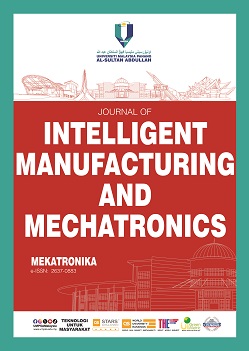Tele-operated Rehabilitation Robot for Forearm Pronation and Supination in Home-Based Therapy
DOI:
https://doi.org/10.15282/mekatronika.v6i1.10338Keywords:
Rehabilitation robot, Tele-operation, Home-based rehabilitation, Master-slave system, PID controllerAbstract
Patients suffering from neurological injuries undergo clinical rehabilitation to regain functionality of the affected limb. However, frequent visits to the therapist tend to be tedious and time consuming. Tele-operated rehabilitation has the advantage of being accessible to patients from the comfort of their homes. This paper presents a tele-operated master-slave rehabilitation robot for forearm pronation and supination for home-based rehabilitation. The prototype of the robot has been developed to provide the rotational motion at the forearm. Arduino is used as the microcontroller board and DC (direct current) motor is utilized to actuate the system. Potentiometers are incorporated at both sides of the robot to provide angular displacement readings. The position of the master sensor is fed to the slave side and this value is then compared to the current displacement of the slave robot and their difference is adjusted. The communication between the master and slave is carried out using Arduino Ethernet shield over the internet. The mathematical model of the robot has been approximated by the dynamic equation of a flywheel. A Proportional Integral Derivative (PID) controller has been implemented on the system to improve its performance. Hardware experimental tests has been conducted and the results verify that the slave robot has successfully followed the master robot’s trajectory as required in the design objective with a time delay of 0.1 s. The resulting percentage overshoot is obtained as 17% and the steady state error is 4%.
References
N. Z. AZLAN and N. S. LUKMAN, “Assist as Needed Control Strategy for Upper Limb Rehabilitation Robot in Eating Activity,” IIUM Engineering Journal, vol. 22, no. 1, pp. 298–322, Jan. 2021, doi: 10.31436/IIUMEJ.V22I1.1480.
Z. A. Adeola-Bello, N. Z. Azlan, and S. A. A. Hassan, “Control Strategy For Power Assist Upper Limb Rehabilitation Robot With The Therapist’s Motion Intention Prediction,” IIUM Engineering Journal, vol. 24, no. 1, pp. 285–300, 2023, doi: 10.31436/iiumej.v24i1.2604.
S. Y. A. Mounis, N. Z. Azlan, and F. Sado, “Assist-as-needed robotic rehabilitation strategy based on z-spline estimated functional ability,” IEEE Access, vol. 8, pp. 157557–157571, 2020, doi: 10.1109/ACCESS.2020.3019450.
D. Buongiorno, D. Chiaradia, S. Marcheschi, M. Solazzi, and A. Frisoli, “Multi-DoFs exoskeleton-based bilateral teleoperation with the time-domain passivity approach,” Robotica, vol. 37, no. 9, pp. 1641–1662, Sep. 2019, doi: 10.1017/S0263574719000171.
V. Arakelian, “Mechanisms and Machine Science Gravity Compensation in Robotics.” [Online]. Available: https://link.springer.com/bookseries/8779
M. M. R. Khan et al., “Development of a Robot-Assisted Telerehabilitation System With Integrated IIoT and Digital Twin,” IEEE Access, vol. 11, pp. 70174–70189, 2023, doi: 10.1109/ACCESS.2023.3291803.
T. Zheng et al., “Design of a Robot for Inspecting the Multishape Pipeline Systems,” IEEE/ASME Transactions on Mechatronics, vol. 27, no. 6, pp. 4608–4618, Dec. 2022, doi: 10.1109/TMECH.2022.3160728.
D. Buongiorno, E. Sotgiu, D. Leonardis, S. Marcheschi, M. Solazzi, and A. Frisoli, “WRES: A Novel 3 DoF WRist ExoSkeleton with Tendon-Driven Differential Transmission for Neuro-Rehabilitation and Teleoperation,” IEEE Robot Autom Lett, vol. 3, no. 3, pp. 2152–2159, Jul. 2018, doi: 10.1109/LRA.2018.2810943.
Z. Yang and S. Guo, “Premilitary Performance Evaluation of Model-mediated Telerehabilitation System with Task Stiffness Estimation,” in 2023 IEEE International Conference on Mechatronics and Automation, ICMA 2023, Institute of Electrical and Electronics Engineers Inc., 2023, pp. 467–472. doi: 10.1109/ICMA57826.2023.10216104.
H. H. Le, M. J. Loomes, and R. C. Loureiro, “AI enhanced collaborative human-machine interactions for home-based telerehabilitation,” J Rehabil Assist Technol Eng, vol. 10, p. 205566832311567, Jan. 2023, doi: 10.1177/20556683231156788.
Downloads
Published
Issue
Section
License
Copyright (c) 2024 The Author(s)

This work is licensed under a Creative Commons Attribution-NonCommercial 4.0 International License.




